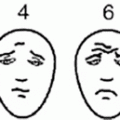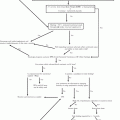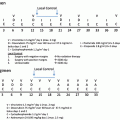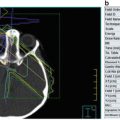Fig. 20.1
Clinical presentation of retinoblastoma (a) leukocoria (b) massive orbital dissemination
Biology and Patterns of Spread
Regardless of the specific mutation, the tumor grows from the nuclear layer of the retina either in an endophytic pattern seeding the vitreous or in an exophytic form into the subretinal space and to the choroid in more advanced states. Retinoblastoma usually produces a retinal detachment, and usually eyes with advanced disease show features of both exophytic and endophytic tumors. After filling the eye, retinoblastoma may disseminate to other organs. It usually does so after involving severely the eye structures, so metastatic dissemination is virtually not existent in cases with small tumors limited to the retina. Thus, extension inside the eye is usually a requisite before metastatic dissemination. The tumor can extend through the optic nerve and/or the subarachnoid space to the chiasm, the brain, and later to the meninges. Exophytic tumors may invade the choroid and later the sclera. The tumor usually remain into the eyeball for some period of time, but if left untreated, it eventually invades the orbit and beyond it to the surrounding structures. The metastatic pattern of retinoblastoma include the CNS and hematogenous metastasis involving the bone, bone marrow, or less frequently any other organ.
Histology
The diagnosis of retinoblastoma is usually made by an experienced ophthalmologist without needing pathological confirmation. However, after the eye is enucleated, it is extremely important that the eyeball is evaluated by an experienced pathologist in order to estimate with accuracy the degree and extent of tumoral dissemination in the eye structures. Retinoblastoma usually presents with small undifferentiated anaplastic cells with scanty cytoplasm and large nuclei, occasionally showing photoreceptor features. Calcification is a frequent finding. Retinoblastoma is a tumor of neuroepithelial origin and presents some similar characteristics to other neuroectodermic pediatric tumors. Thus tumor cells often express photoreceptor-differentiation antigens, neuron-specific enolase, and the ganglioside GD2. Retinoblastoma usually stains negative to CD99. However, immunohistochemistry is not vital to the diagnosis of retinoblastoma. Immunocytological evaluation is nevertheless important in cases of extraocular dissemination where tumoral cells should be readily identified by these techniques. The use of immunocytology for GD2 or for the transcription factor CRX has been reported effective for this goal [10]. The likelihood of extraocular relapse is directly correlated with microscopical invasion to critical eye structures such as the optic nerve in its orbital portion beyond the lamina cribrosa, the choroid when is massively invaded and the sclera that implies always a later stage of choroidal invasion [11].
Diagnostic and Extent of Disease Evaluation
When a child is diagnosed with retinoblastoma, it is important to assess the extent of the disease in two levels: (a) intraocular extension, which will predict eye salvage and (b) extraocular dissemination, which will predict patient survival.
Intraocular extension of retinoblastoma is assessed by the ophthalmologist using the indirect ophthalmoscope in a full examination with pupillary dilation under anesthesia. The extent of intraocular disease evaluation should consider the size of the tumors, their location especially their relationship to the macula and the presence of seeding to the vitreous or the subretinal space. On occasions, the tumor causes retinal detachment, which was previously regarded as a poor prognosis feature. Different systems were proposed to group these findings in order to predict eye salvage. The Reese-Ellsworth (R-E) grouping system was used for many years and proved to be effective in predicting eye salvage with radiotherapy treatment. More recently, an international system was proposed to predict eye salvage with modern chemotherapy treatments (Table 20.1) [12].
Table 20.1
The International Grouping System for intraocular disease
Group A |
Small tumors away from foveola and disc |
• Tumors ≤3 mm in greatest dimension confined to the retina |
• Located at least 3 mm from the foveola and 1.5 mm from the optic disc |
Group B |
All remaining tumors confined to the retina |
• All other tumors confined to the retina not in Group A |
• Subretinal fluid (without subretinal seeding) ≤3 mm from the base of the tumor |
Group C |
Local subretinal fluid or seeding |
• Local subretinal fluid alone >3 to ≤ 6 mm from the tumor |
• Vitreous seeding or subretinal seeding ≤3 mm from the tumor |
Group D |
Diffuse subretinal fluid or seeding |
• Subretinal fluid alone >6 mm from the tumor |
• Vitreous seeding or subretinal seeding >3 mm from tumor |
Group E |
Presence of any or more of these poor prognosis features |
• Tumor in anterior segment |
• Tumor in or on the ciliary body |
• Iris neovascularization |
• Neovascular glaucoma |
• Opaque media from hemorrhage |
• Tumor necrosis with aseptic orbital cellulitis |
• Phthisis bulbi |
The evaluation of extraocular extension is usually done by the pediatric oncologist. For a proper extent of extraocular disease evaluation it is important to consider the prevalence of extraocular disease in a given patient population. Since extraocular retinoblastoma is very uncommon in developed countries, most authors recommend that no other staging procedure other than CNS imaging should be done for staging [13]. The low prevalence dissemination in the CSF or in the bone marrow makes evaluation of these sites of low yield and most authors in developed countries do not perform these evaluations routinely in their patients. However, in developing countries with high prevalence of these complications, a full extent of disease evaluation may be needed in most patients [14]. Because extraocular disease is so uncommon in developed countries, there has not been a consensus staging system for extraocular disease for years. However, in recent years, a group of international retinoblastoma experts developed a staging system by consensus that articulates with the intraocular grouping system proposed for the eye-conserving therapies with chemoreduction (Table 20.2) [15]. The TNM system has been recently updated in order to include patients with extraocular dissemination. So, each retinoblastoma program in developing countries should chose the staging system that better accommodates with their patient population, but it is important to be consistent in the use of a specific staging system over time in order to be able to compare the results.
Table 20.2
The International Staging for Retinoblastoma
Stage 0: Patients treated conservatively (subject to presurgical ophthalmologic classifications) |
Stage I: Eye enucleated, completely resected histologically |
Stage II: Eye enucleated, microscopic residual tumor |
Stage III: Regional extension |
(a) Overt orbital disease |
(b) Preauricular or cervical lymph node extension |
Stage IV Metastatic disease |
(a) Hematogenous metastasis: (1) single lesion, (2) multiple lesions |
(b) CNS extension: (1) prechiasmatic lesion, (2) CNS mass, (3) leptomeningeal disease |
Work-Up for Metastatic Disease
Regardless of the disease extension and the setting, all children with retinoblastoma should undergo a head and orbital, gadolinium-enhanced MRI. MRI is preferred to CT scan because it allows for a better estimation of the invasion to the optic nerve [16]. Guidelines for the evaluation of retinoblastoma with MRI have been recently published [16], but it is important to know that in order to obtain a detailed evaluation of the optic nerve or the choroid, it is necessary to use a high-resolution MRI with orbital coils, which are seldom available in developing countries. In addition, MRI is helpful to evaluate the pineal area where it avoids the exposure to radiation in these susceptible patients. However, many centers in developing countries would have only CT scan available for staging of their retinoblastoma patients. In these cases, CT may be useful to identify obvious optic nerve or orbital involvement and CNS extension. Thus, the first step in the initial evaluations in children with retinoblastoma includes a full ophthalmological evaluation and CNS imaging. After this first step, the treating group is able to determine if an eye salvage therapy is possible, if enucleation of the affected eye is needed or if the disease has already spread outside the eye and neoadjuvant therapy is required. At this point, clinical findings are also important to take a decision since children who can only be evaluated with low resolution CT scans and present with massive buphthalmia or glaucoma but imaging studies fail to disclose extension beyond the eyeball may be better treated with preoperative chemotherapy. In these children and in those in whom extraocular disease is present, further staging evaluations are necessary before starting neoadjuvant chemotherapy. These include bilateral bone marrow aspirates and biopsies and lumbar puncture with examination of the cytospin (in those without risks related to the procedure) [14]. A full bone marrow evaluation including bilateral biopsies and aspirates may improve the yield of these procedures, but they need to be done under general anesthesia, which is not always available or recommended in children with advanced disease in developing countries. In situations where children present with obvious extraocular disease, a single bone marrow aspiration could be done, and if the results are positive, no other bone marrow study would be needed. However, a more exhaustive bone marrow evaluation should be done when a single aspiration fails to show malignant cells, especially if no other metastatic site is present. Since retinoblastoma cells may adhere to the tube, the examination of the cytocentrifugate of the CSF specimen, should be always be done regardless of the cell count in order to improve the yield of this procedure. Bone scintigraphy is only recommended in children with confirmed metastatic disease or those with bone pain. This extensive work-up is only necessary at diagnosis in children with clinically advanced disease in whom preoperative enucleation is considered. In cases where enucleation of the affected eye was decided as initial therapy, staging procedures should be done only if high risk of metastatic disease is probably based on the pathological examination. Enucleation should not be delayed because of extent of disease evaluation other than CNS imaging. Children in whom conservative therapy is undertaken do not need any other staging procedure than CNS imaging.
Treatment
The treatment of retinoblastoma in developing countries poses significant and unique challenges for the treating physicians given the paucity of publications, the impact of socioeconomical factors and the influence of the availability of resources. It is important that children with retinoblastoma should be treated in centers with experience in the management of these tumors which on occasions would need the participation of eye hospitals in association with children or cancer centers in order to provide the best possible care. In order to provide tools for treating physicians in these settings, the SIOP-PODC (International Society of Pediatric Oncology-Pediatric Oncology in Developing Countries) published a consensus guideline for graduated-intensity therapy [17].
The Challenges in the Treatment of Unilateral Retinoblastoma: When Is Chemotherapy Indicated?
Initial enucleation of the affected eye is the treatment of choice for children with intraocular unilateral retinoblastoma [18]. It is the simplest and safest therapy for retinoblastoma; however, in some developing countries it is not widely accepted by the affected families. It is important to procure a prosthetic eyeball which can even be fitted in the operating room after the procedure to minimize cosmetic effects. Enucleation should be performed by an experienced pediatric ophthalmologist in order to obtain a long optic nerve stump and avoid eye rupture.
Eyes with secondary glaucoma, invasion of anterior segment (anterior chamber, iris), rubeosis iridis, hyphema, pseudohypopyon, and history of orbital cellulitis or those with affection of more than 2/3 of the retina or massive vitreous or subretinal seeding should be enucleated initially without delay. In some developing countries, as many as two-thirds of children present with enlarged eyeballs, that have a higher risk of microscopic extraocular dissemination [19–21]. These eyes may be difficult to enucleate and are at high risk of rupture [22], which would cause tumor seeding in the orbit. Occasionally, the tumor may be left behind in the resection margin of the optic nerve. These cases are at high risk of death if no further treatment is given and they need intensive chemotherapy and orbital radiotherapy to have a chance for cure. In many of these settings, radiotherapy and intensive chemotherapy are unfortunately not available. In these cases, pre-enucleation chemotherapy may theoretically reduce the tumoral volume in severely buphthalmic eyes, thereby reducing these risks [22]. If pre-enucleation chemotherapy is used, these children should be considered at higher risk for extraocular relapse and adjuvant chemotherapy should be given in all cases, regardless of the pathologic findings upon examination of the enucleated eye [23, 24]. It is important to enucleate these eyes no later than two or three chemotherapy cycles, because chemotherapy resistance may ensue, and the child may die of disseminated disease [25]. Enucleation is always needed in these cases, even when tumor response to neoadjuvant chemotherapy is spectacular, and no local therapy should be done.
After enucleation is done, the affected eyeball should be examined by an expert pathologist. Guidelines for uniform processing of enucleated eyes and for definition of involvement of the different eye structures have been published [26]. These guidelines are applicable in most centers since they do not imply any sophisticated procedure [26]. Centers managing cases where invasion to ocular coats is common should give priority to obtain a high-quality pathology examination. The pediatric oncologist uses this information to decide the need for adjuvant chemotherapy after enucleation. It is essential to identify invasion to the optic nerve, especially when it is beyond the lamina cribrosa paying particular attention to the status of the resection margin, the presence and extent of choroidal invasion, and any degree of scleral involvement. These children benefit from adjuvant chemotherapy but its use in children with other risk factors is controversial and it should be balanced with the potential toxicity of chemotherapy and the availability of second-line therapy in a given setting [11]. So, as a general rule, the use of adjuvant chemotherapy in a given setting should consider the following local scenarios (Table 20.3):
Table 20.3
Use of chemotherapy and radiotherapy in different situations for the treatment of retinoblastoma in developing countries
Clinical situation | Chemotherapy | Radiotherapy | Comments |
|---|---|---|---|
Adjuvant therapy for enucleated patients with high risk histology (Stages I and II) | Carboplatin 500 mg/m2/day 1+ | Only indicated for patients with tumor invasion to the resection margin of the optic nerve | Higher dose regimens including Cyclophosphamide 65 mg/kg/day 1 |
Etoposide 100–150 mg/m2/days 1 and 2 + | |||
Dose: 4,500 cGy to the orbit, including the chiasm | |||
Vincristine 1.5 mg/m2/day 1 | Vincristine 1.5 mg/m2/day 1 | ||
Idarubicin 10 mg/m2/day 1 (may be replaced by doxorubicin 30 mg/m2/day 1) may be more effective in higher risk patients | |||
Orbital retinoblastoma (Stage III) | Carboplatin 500 mg/m2/day 1+ | Dose: 4,500 cGy to the orbit, including the chiasm | Chemotherapy is usually given as neoadjuvant followed by secondary enucleation and adjuvant chemo and radiotherapy. Higher dose regimens including Cyclophosphamide 65 mg/kg/day 1 |
Etoposide 100–150 mg/m2/days 1 and 2+ Vincristine 1.5 mg/m2/day 1 | |||
Vincristine 1.5 mg/m2/day 1 | |||
Idarubicin 10 mg/m2 day 1 (may be replaced by doxorubicin 30 mg/m2/day 1) | |||
Metastatic retinoblastoma (uni and bilateral) (Stage IV) | Option 1: Carboplatin 500 mg/m2/days 1 and 2+ Etoposide 100 mg/m2/days 1–3 | As palliative treatment and for the treatment of bulk disease persisting after high dose chemotherapy | When high dose chemotherapy and stem cell transplantation is not available palliative therapy may be considered. Regimens useful for conservative therapy are usually well tolerated. For children in extremely poor condition, oral chemotherapy with etoposide or cyclophosphamide may be used |
Alternating with Cyclophosphamide 65 mg/kg/day 1+
Stay updated, free articles. Join our Telegram channel
Full access? Get Clinical Tree
 Get Clinical Tree app for offline access
Get Clinical Tree app for offline access

|




